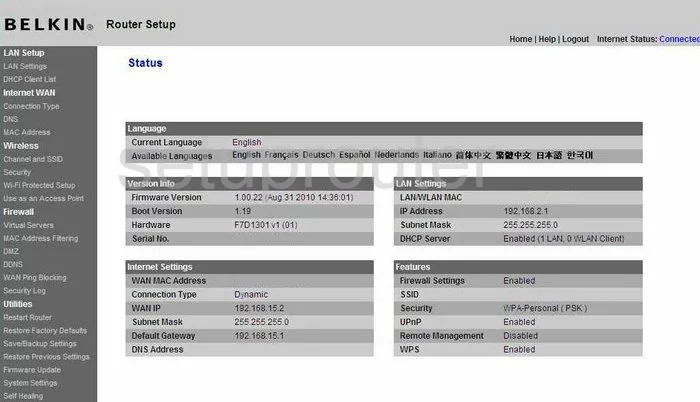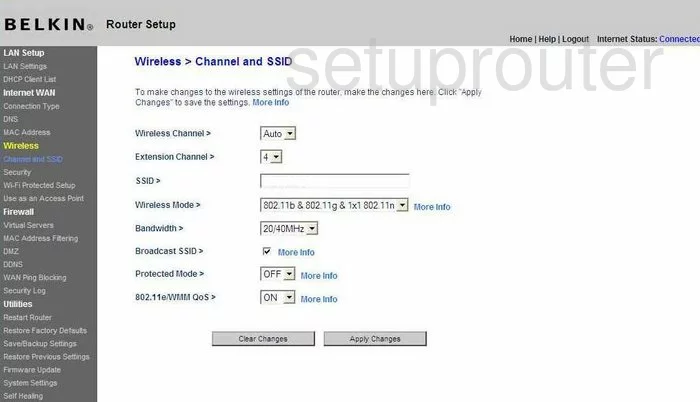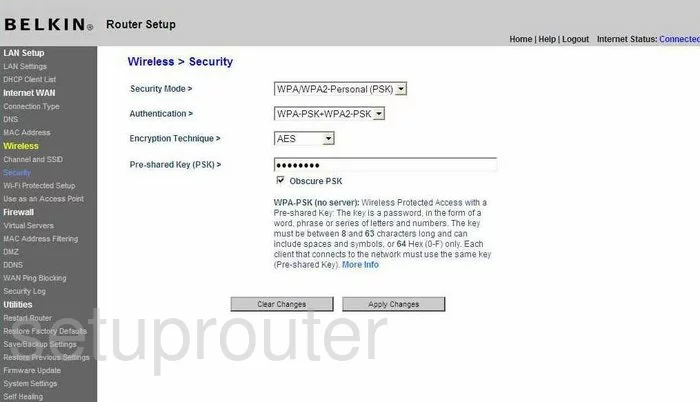The Belkin F7D1301 router is considered a wireless router because it offers WiFi connectivity. WiFi, or simply wireless, allows you to connect various devices to your router, such as wireless printers, smart televisions, and WiFi enabled smartphones.
Other Belkin F7D1301 Guides
This is the wifi guide for the Belkin F7D1301 v1. We also have the following guides for the same router:
- Belkin F7D1301 v1 - How to change the IP Address on a Belkin F7D1301 router
- Belkin F7D1301 v1 - Belkin F7D1301 Login Instructions
- Belkin F7D1301 v1 - Belkin F7D1301 User Manual
- Belkin F7D1301 v1 - Belkin F7D1301 Port Forwarding Instructions
- Belkin F7D1301 v1 - How to change the DNS settings on a Belkin F7D1301 router
- Belkin F7D1301 v1 - How to Reset the Belkin F7D1301
- Belkin F7D1301 v1 - Information About the Belkin F7D1301 Router
- Belkin F7D1301 v1 - Belkin F7D1301 Screenshots
WiFi Terms
Before we get started there is a little bit of background info that you should be familiar with.
Wireless Name
Your wireless network needs to have a name to uniquely identify it from other wireless networks. If you are not sure what this means we have a guide explaining what a wireless name is that you can read for more information.
Wireless Password
An important part of securing your wireless network is choosing a strong password.
Wireless Channel
Picking a WiFi channel is not always a simple task. Be sure to read about WiFi channels before making the choice.
Encryption
You should almost definitely pick WPA2 for your networks encryption. If you are unsure, be sure to read our WEP vs WPA guide first.
Login To The Belkin F7D1301
To get started configuring the Belkin F7D1301 WiFi settings you need to login to your router. If you are already logged in you can skip this step.
To login to the Belkin F7D1301, follow our Belkin F7D1301 Login Guide.
Find the WiFi Settings on the Belkin F7D1301
If you followed our login guide above then you should see this screen.

You begin on the Status page of the Belkin F7D1301v1 router. To configure the WiFi settings click the link on the left side of the page labeled Channel and SSID.
Change the WiFi Settings on the Belkin F7D1301

You are directed to a page titled Wireless > Channel and SSID. There are two things that may need to be changed on this page.
- Wireless Channel - This is the channel that your wireless network is transmitted on. If you are not getting the reception you think you should, change the channel to 1,6, or 11. You need to be on one of these three channels. There is only room in the spectrum for up to three channels that don't partially overlap. These three are the most you can get out of the spectrum. Check our WiFi channels guide for more on this subject.
- SSID - This is the name you give your network so you can identify it. If you leave the default name on here, you may be inviting a hacker to try and hack your network. They assume that since you didn't change this name, maybe you didn't change the password either, making you an easy target. Don't use personal information in this name. Check our Wireless names guide for more on this topic.
That's all that needs to be changed on this page. Go ahead and click the Apply Changes button. Then, in the left sidebar, click the link titled Security.

This takes you to a page like the one above titled Wireless > Security.
- Security Mode - This is the security you use for your network. There are several options here. Check our guide titled WEP vs. WPA for more details. The best choice for your security mode is WPA/WPA2-Personal (PSK).
- Authentication - This is just narrowing your choice down even further. The best choice is WPA2-PSK.
- Encryption Technique - Now that you have chosen the style of security you will use, how do you want to encrypt it? Your choices are TKIP or AES. TKIP is the older of the two and flaws have been found that make it more vulnerable. We recommend AES, it is newer and is considered very secure.
- Pre-Shared Key (PSK) - This is the password you use to access your network. It is also used in the encryption method so it needs to be strong. We recommend using at least 20 characters. For a password, length does matter. Avoid using any words found in a dictionary, these are easily cracked with dictionary programs. Avoid using any personal information, these are easier to guess. We do recommend using some symbols, numbers, and capital letters in the password. For more on this, check out our guide titled Choosing a strong password.
That's it, just click the Apply Changes button before you exit.
Possible Problems when Changing your WiFi Settings
After making these changes to your router you will almost definitely have to reconnect any previously connected devices. This is usually done at the device itself and not at your computer.
Other Belkin F7D1301 Info
Don't forget about our other Belkin F7D1301 info that you might be interested in.
This is the wifi guide for the Belkin F7D1301 v1. We also have the following guides for the same router:
- Belkin F7D1301 v1 - How to change the IP Address on a Belkin F7D1301 router
- Belkin F7D1301 v1 - Belkin F7D1301 Login Instructions
- Belkin F7D1301 v1 - Belkin F7D1301 User Manual
- Belkin F7D1301 v1 - Belkin F7D1301 Port Forwarding Instructions
- Belkin F7D1301 v1 - How to change the DNS settings on a Belkin F7D1301 router
- Belkin F7D1301 v1 - How to Reset the Belkin F7D1301
- Belkin F7D1301 v1 - Information About the Belkin F7D1301 Router
- Belkin F7D1301 v1 - Belkin F7D1301 Screenshots